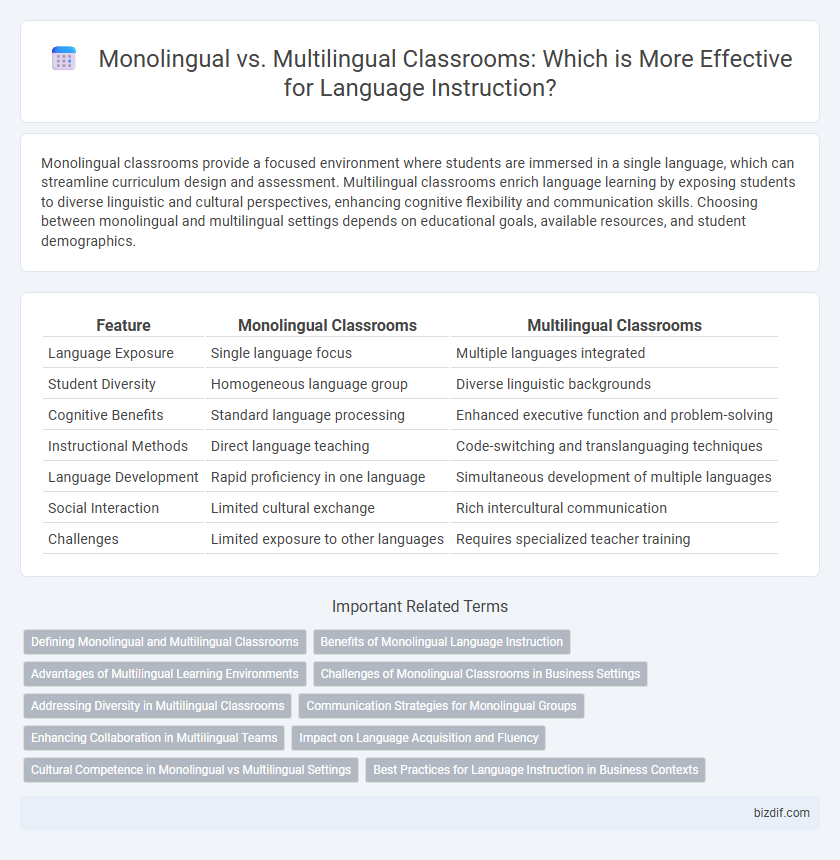Monolingual classrooms provide a focused environment where students are immersed in a single language, which can streamline curriculum design and assessment. Multilingual classrooms enrich language learning by exposing students to diverse linguistic and cultural perspectives, enhancing cognitive flexibility and communication skills. Choosing between monolingual and multilingual settings depends on educational goals, available resources, and student demographics.
Table of Comparison
| Feature | Monolingual Classrooms | Multilingual Classrooms |
|---|---|---|
| Language Exposure | Single language focus | Multiple languages integrated |
| Student Diversity | Homogeneous language group | Diverse linguistic backgrounds |
| Cognitive Benefits | Standard language processing | Enhanced executive function and problem-solving |
| Instructional Methods | Direct language teaching | Code-switching and translanguaging techniques |
| Language Development | Rapid proficiency in one language | Simultaneous development of multiple languages |
| Social Interaction | Limited cultural exchange | Rich intercultural communication |
| Challenges | Limited exposure to other languages | Requires specialized teacher training |
Defining Monolingual and Multilingual Classrooms
Monolingual classrooms consist of students who share the same native language, facilitating instruction primarily in that single language. Multilingual classrooms encompass learners from diverse linguistic backgrounds, requiring educators to integrate multiple languages and cultural perspectives into the curriculum. Understanding these definitions helps tailor language instruction strategies that support effective communication and learning outcomes in varied linguistic settings.
Benefits of Monolingual Language Instruction
Monolingual classrooms provide a focused language environment that enhances fluency and mastery of the target language through consistent exposure and practice. This approach simplifies curriculum design and assessment, allowing educators to tailor instruction specifically to one linguistic framework. Students benefit from reduced cognitive load and clearer linguistic input, which can accelerate language acquisition and reinforce standardized language proficiency.
Advantages of Multilingual Learning Environments
Multilingual classrooms promote cognitive flexibility by exposing students to diverse linguistic structures and cultural perspectives, enhancing problem-solving and critical thinking skills. These environments foster greater empathy and intercultural competence, preparing learners for global communication and collaboration. Research shows that multilingual instruction improves metalinguistic awareness and academic achievement across subjects compared to monolingual settings.
Challenges of Monolingual Classrooms in Business Settings
Monolingual classrooms in business settings often face challenges such as limited cultural diversity and reduced opportunities for global communication skill development. Employees trained exclusively in one language may struggle with understanding international markets and diverse client needs, hindering overall business expansion. This limitation also affects collaboration in multinational teams, where language barriers can impede effective communication and productivity.
Addressing Diversity in Multilingual Classrooms
Multilingual classrooms embrace linguistic diversity by integrating culturally responsive teaching methods that support students' native languages while developing proficiency in the target language. Strategies such as differentiated instruction, collaborative learning, and scaffolded language support address varying levels of language ability and promote inclusivity. Research shows that leveraging students' multilingual backgrounds enhances cognitive skills and academic achievement by fostering a more engaging and supportive learning environment.
Communication Strategies for Monolingual Groups
Monolingual classrooms emphasize communication strategies such as repetitive practice, visual aids, and context-based conversations to enhance language acquisition. Teachers often use simplified vocabulary, structured dialogues, and peer interactions to promote fluency within a single language group. These methods support clearer understanding and reinforce language patterns crucial for monolingual learners.
Enhancing Collaboration in Multilingual Teams
Multilingual classrooms significantly enhance collaboration by fostering diverse language skills and cultural perspectives, which improve communication and problem-solving within teams. Research shows that students in multilingual environments develop higher empathy and adaptability, key factors in effective teamwork and innovation. Integrating multilingual strategies supports not only language acquisition but also strengthens interpersonal dynamics essential for collaborative success.
Impact on Language Acquisition and Fluency
Monolingual classrooms often provide a focused environment that accelerates language acquisition by immersing students in a single language, promoting consistent practice and fluency development. Multilingual classrooms support cognitive flexibility and cross-linguistic transfer, which can enhance overall language proficiency and adaptability, although language acquisition may occur at a varied pace depending on individual linguistic backgrounds. Research indicates that balanced exposure and targeted instructional strategies in either setting significantly influence the effectiveness of language fluency outcomes.
Cultural Competence in Monolingual vs Multilingual Settings
Monolingual classrooms limit cultural competence by exposing students primarily to a single linguistic and cultural perspective, which restricts their understanding of global diversity. Multilingual classrooms enhance cultural competence by fostering an environment where students actively engage with multiple languages and cultural identities, promoting empathy and cross-cultural communication skills. Research shows that students in multilingual settings develop stronger intercultural awareness and adaptability essential for success in diverse societies.
Best Practices for Language Instruction in Business Contexts
In business contexts, effective language instruction in monolingual classrooms emphasizes immersive communication strategies and industry-specific vocabulary to build professional fluency. Multilingual classrooms benefit from leveraging code-switching techniques and cross-linguistic transfer to enhance understanding and collaboration among diverse learners. Tailoring instruction to real-world business scenarios and cultural nuances optimizes language acquisition and workplace communication skills.
Monolingual Classrooms vs Multilingual Classrooms Infographic

 bizdif.com
bizdif.com